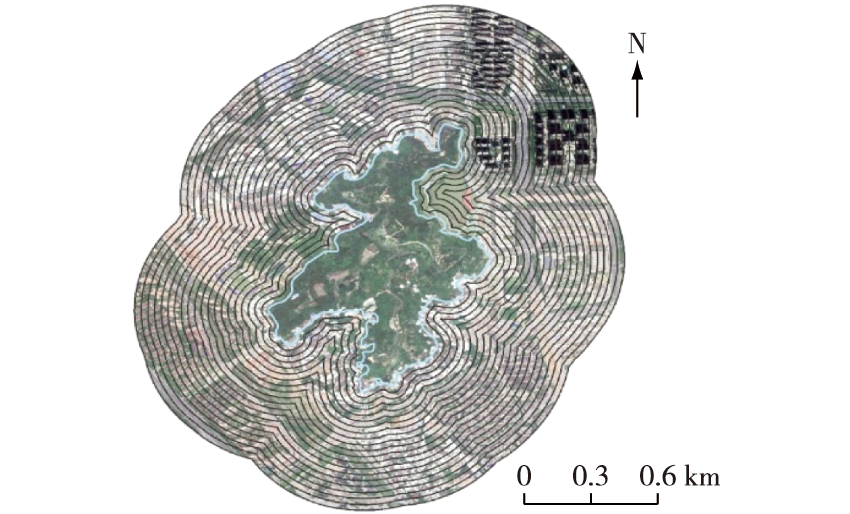 PDF(4793 KB)
PDF(4793 KB)


The cold island effect and its influence on urban parks in Fuzhou City, China
LIU Yanfen, HUANG Ruxian, AI Jinwen, YANG Liuqing, YU Kunyong, LIU Jian
JOURNAL OF NANJING FORESTRY UNIVERSITY ›› 2024, Vol. 48 ›› Issue (3) : 295-303.
 PDF(4793 KB)
PDF(4793 KB)
 PDF(4793 KB)
PDF(4793 KB)
The cold island effect and its influence on urban parks in Fuzhou City, China
【Objective】 Urban park represent an important land use strategy to mitigate the urban heat island effect. In this study, we analyzed the influences of urban park landscape features on the cold-island effect. We also determined the scale threshold of urban parks based on the urban park cooling threshold (TVoE) concept to assess the ability of urban parks to mitigate the urban thermal environment. Our findings provide a theoretical basis for designing urban parks that can mitigate the thermal environment with maximum efficiency. 【Method】 Using surface temperatures and land use data extracted from Landsat remote sensing image inversion, the buffer zone method was applied to calculate the characteristics of the cold-island effect in urban parks. We then quantified the cold-island effect in urban parks in Fuzhou City from three perspectives: cooling distance, magnitude, and gradient, and analyzed its influencing factors based on the landscape characteristics of urban parks. 【Result】 (1) Urban parks in Fuzhou City exhibited obvious cold-island effects. Specifically, the characteristic cooling distance was 0.1-0.6 km, the cooling magnitude was 0.02-8.50 ℃, and the cooling gradient was 0.04-17.00 ℃/km. (2) The temperature in urban parks and the cold-island effect index were negatively correlated with the area, perimeter, and shape index. According to the fitting results of the park temperature and cooling gradient curves, the urban park area threshold ranges from 0.768 to 50 hm2. (3) There were differences in the degree of the cold-island effect related to the ratios of green space and water body areas in urban parks. Based on the cold-island effect characteristics achieved by the smallest urban park area (0.768 hm2), the total green space and water body areas in urban parks with water bodies were greater than 53.39%, whereas the total green space area in urban parks without water bodies was greater than 72.46%. 【Conclusion】 The landscape characteristics of urban parks influence the cold-island effect and have threshold intervals. The design process for urban parks in Fuzhou City should control their areas in the range of 0.768-50 hm2. Landscape design that addresses green space and water areas and distributions would maximize the benefits of mitigating the urban thermal environment, thereby improving urban habitats in the limited urban landscape.

urban park / cold island effect / buffer zone analysis / cooling threshold / Fuzhou City
| [1] |
|
| [2] |
|
| [3] |
|
| [4] |
苏从先, 胡隐樵, 张永丰, 等. 河西地区绿洲的小气候特征和“冷岛效应”[J]. 大气科学, 1987, 11(4):390-396.
|
| [5] |
|
| [6] |
|
| [7] |
|
| [8] |
|
| [9] |
景高莉, 张建军, 程明芳, 等. 城市绿色空间对周边热环境的降温规律[J]. 江苏农业科学, 2017, 45(22):289-294.
|
| [10] |
董丽. 城市公园绿地对周围城市环境的降温效应及其影响因子研究[C]// 中国风景园林学会2017年会论文集.西安, 2017:306-313.
|
| [11] |
|
| [12] |
|
| [13] |
|
| [14] |
花利忠, 孙凤琴, 陈娇娜, 等. 基于Landsat-8影像的沿海城市公园冷岛效应:以厦门为例[J]. 生态学报, 2020, 40(22):8147-8157.
|
| [15] |
|
| [16] |
|
| [17] |
|
| [18] |
王新军, 冯星莹, 陈凯莉, 等. 城市公园的冷岛效应研究:以常州市为例[J]. 中国环境科学, 2021, 41(9): 4245-4252.
|
| [19] |
|
| [20] |
阚增辉, 刘朝顺, 李志军. 基于Landsat-8热红外数据的太湖地区地表温度反演与热岛效应分析[J]. 华东师范大学学报(自然科学版), 2016(4): 129-138,168.
|
| [21] |
|
| [22] |
|
| [23] |
|
| [24] |
|
| [25] |
|
| [26] |
范梦池. 城市公园声景观评价与预测[D]. 杭州: 浙江大学, 2019.
|
| [27] |
许浩, 金婷, 刘伟. 苏锡常都市圈蓝绿空间规模与格局演变特征[J]. 南京林业大学学报(自然科学版), 2022, 46(1): 219-226.
|
| [28] |
|
| [29] |
|
| [30] |
杨朝斌, 张亭, 胡长涛, 等. 蓝绿空间冷岛效应时空变化及其影响因素:以苏州市为例[J]. 长江流域资源与环境, 2021, 30(3): 677-688.
|
| [31] |
苏泳娴, 黄光庆, 陈修治, 等. 广州市城区公园对周边环境的降温效应[J]. 生态学报, 2010, 30(18): 4905-4918.
|
| [32] |
石蕾洁, 赵牡丹. 城市公园夏季冷岛效应及其影响因素研究:以西安市中心城区为例[J]. 干旱区资源与环境, 2020, 34(5): 154-161.
|
| [33] |
|
/
| 〈 |
|
〉 |